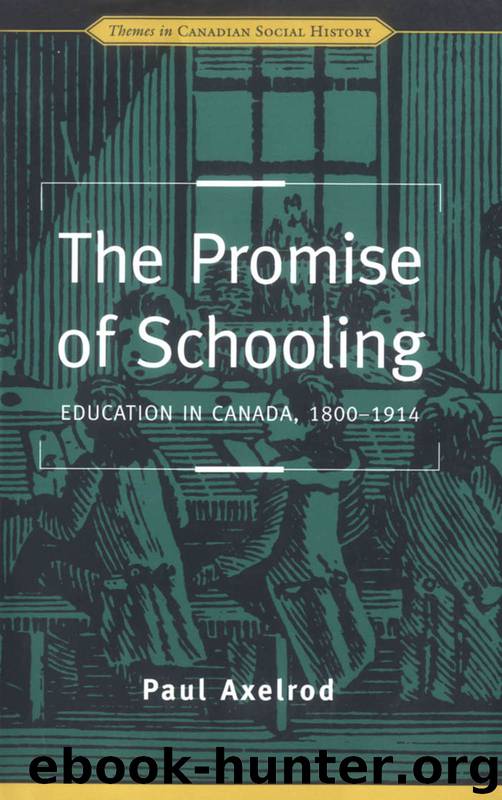The Promise of Schooling by Unknown

Author:Unknown
Language: eng
Format: epub
Tags: HIS006000
Publisher: University of Toronto Press
Published: 1997-05-01T16:00:00+00:00
Though associated primarily with the American South, slavery endured in the British colonies in the eighteenth and early nineteenth centuries, as it had earlier during the French regime, and was not officially abolished in the British Empire until 1833. Brought to Nova Scotia by New England settlers in the 1750s and by Loyalist immigrants after the American Revolution, black slaves numbered some 1,500 by the early 1780s. In addition, as part of the British plan to debilitate the economy of the Southern states, and to recruit labour for the British forces, some 3,000 ‘emancipated’ blacks were drawn to the colonies, mainly to Nova Scotia, in 1783. Granted far less land by the British government than that received by white Loyalists, blacks in Nova Scotia endured poverty and discrimination, a condition that was reflected in the poor quality of schooling they received throughout the nineteenth century.
A second wave of American blacks came to the Maritimes and Upper Canada during the War of 1812, when the British government offered to free all slaves who deserted their American masters. Slavery again drove blacks to Canada after 1850, when the Fugitive Slave Law rendered the Northern American states as dangerous to fleeing slaves as was the South. Concentrated in a number of communities in Nova Scotia and Ontario, in the 1850s blacks comprised some 8 per cent of the population of Halifax, and more than half the population in some communities around the city. Between one-fifth and one-third of the residents of Chatham, Amherstburg, and Colchester in southwestern Ontario were black.
In the era before the rise of public schooling, black children in Nova Scotia and Ontario were educated, if at all, in philanthropic or missionary schools run by organizations such as the Society for the Propagation of the Gospel. A notable initiative had been taken in 1813 by a retired officer, Captain Walter Henry Bromley, who opened a Lancasterian monitorial school for poor whites, blacks, and Mi’kmaq Indians in Halifax. On occasion, common schools were effectively integrated, such as the Buxton School, near Chatham, Ontario, whose academic reputation was so high by the 1850s that it drew students from as far away as the United States. But this was an exception. In the face of thriving prejudice, ‘coloured’ children were almost always unwelcome and were normally educated in segregated black-only schools.
So opposed were white Canadians to the ‘mixing’ of the races that provincial laws legitimized the practice of ‘separate’ schooling under the guise of respecting minority rights. In Canada West, the Separate School Act of 1850 provided that any group of five black families could petition for a separate ‘coloured’ school, which in practice enabled white parents and trustees to bar or oust black children from common schools anywhere that an alternative facility existed or could be created. The Nova Scotian law permitted school commissioners of any municipality to ‘establish separate schools if they, rather than a body of petitioners, thought them necessary and if the government approved.’ Several attempts – all unsuccessful – were made to force the withdrawal of this legislation, though in 1884 an amend-.
Download
This site does not store any files on its server. We only index and link to content provided by other sites. Please contact the content providers to delete copyright contents if any and email us, we'll remove relevant links or contents immediately.
Cecilia; Or, Memoirs of an Heiress — Volume 2 by Fanny Burney(31909)
Cecilia; Or, Memoirs of an Heiress — Volume 3 by Fanny Burney(31893)
Fanny Burney by Claire Harman(26560)
We're Going to Need More Wine by Gabrielle Union(19003)
Plagued by Fire by Paul Hendrickson(17370)
All the Missing Girls by Megan Miranda(15777)
Cat's cradle by Kurt Vonnegut(15258)
Bombshells: Glamour Girls of a Lifetime by Sullivan Steve(14022)
For the Love of Europe by Rick Steves(13584)
Leonardo da Vinci by Walter Isaacson(13235)
4 3 2 1: A Novel by Paul Auster(12330)
The remains of the day by Kazuo Ishiguro(8892)
Adultolescence by Gabbie Hanna(8887)
Note to Self by Connor Franta(7645)
Diary of a Player by Brad Paisley(7520)
Giovanni's Room by James Baldwin(7252)
What Does This Button Do? by Bruce Dickinson(6169)
Ego Is the Enemy by Ryan Holiday(5347)
Born a Crime by Trevor Noah(5335)
